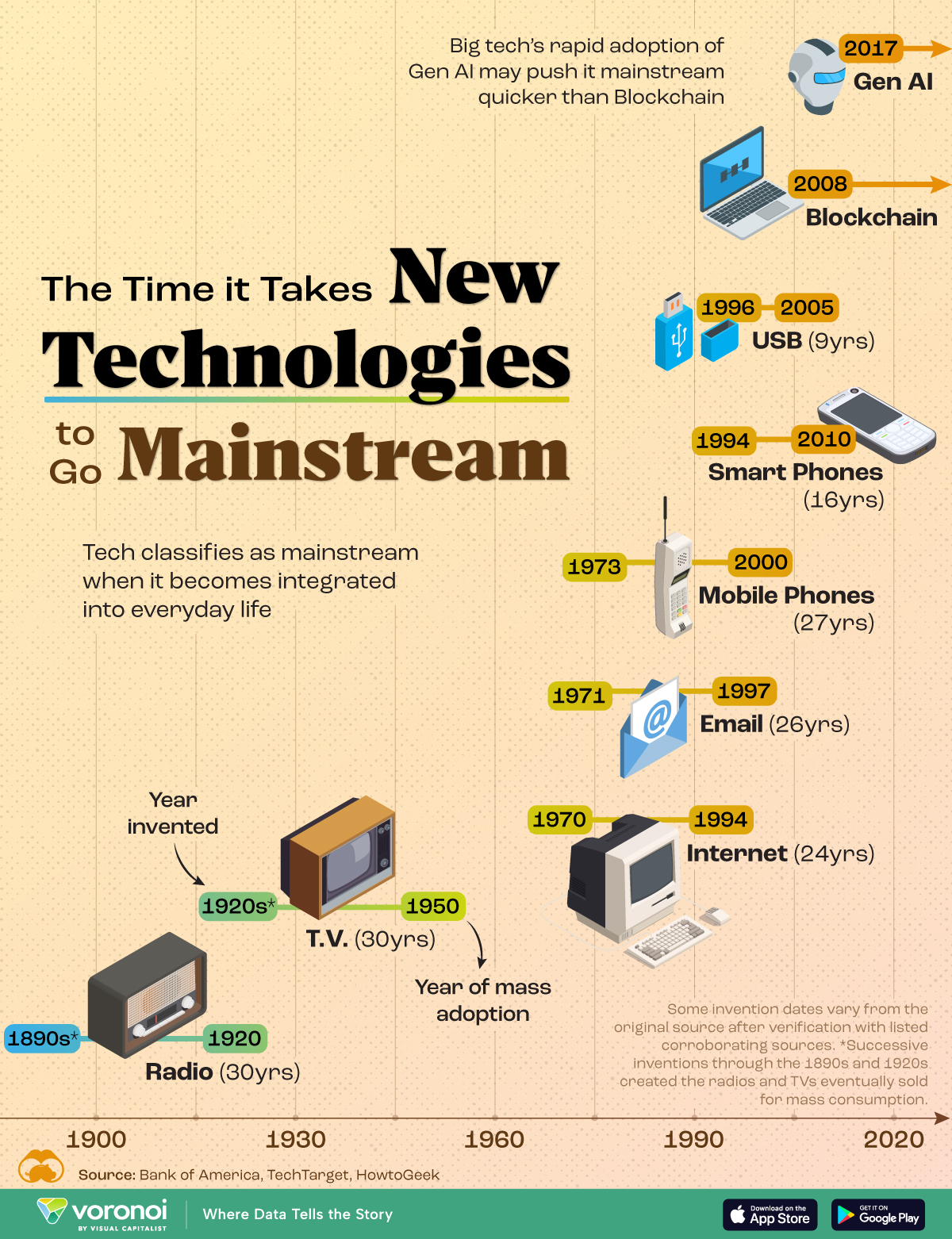Pallavi Rao
2024-10-14 08:18:00
www.visualcapitalist.com
Charted: The Speed at Which New Technologies Go Mainstream
This was originally posted on our Voronoi app. Download the app for free on iOS or Android and discover incredible data-driven charts from a variety of trusted sources.
Innovation cycles tend to build upon each other, reducing the time taken between each milestone.
For example, the first wave of the Industrial Revolution took half a century, while later advancements like electrification occurred in just a few decades, and today’s digital innovations happen in just a few years.
As a result, the mainstream adoption of new technology has accelerated. We illustrate this phenomenon by comparing the invention year of disruptive technologies with the year they became widely adopted.
Data is sourced from the Bank of America’s “AI: From Evolution to Revolution” report, published in September 2024. Some invention dates vary from the original source after verification with other listed corroborating sources: The Guardian, TechTarget, and HowToGeek.
How Long Will it Take Generative AI to Become Mainstream?
It took radio and TV at least three decades to go from invention to mainstream use. And once they proliferated, an entirely new sector—mass media—evolved, a key driver of globalization.
| Year | Invention | Mass Adoption | # of Years |
|---|---|---|---|
| 1890s* |  Radio Radio |
1920 | 30 |
| 1920s* |  TV TV |
1950 | 30 |
| 1970 |  Internet Internet |
1994 | 24 |
| 1971 |  Email Email |
1997 | 26 |
| 1973 |  Mobile Phones Mobile Phones |
2000 | 27 |
| 1994 |  Smartphones Smartphones |
2010 | 16 |
| 1996 |  USB USB |
2005 | 9 |
| 2008 |  Blockchain Blockchain |
??? | N/A |
| 2017 |  Generative AI Generative AI |
??? | N/A |
Note: *Multiple inventions through the decades of the 1890s and 1920s eventually created mass-market TVs and radios.
The invention of the internet, email, and mobile phones also followed a roughly 30-year cycle until mass adoption. Each technology required substantial investment and lead time to establish the necessary communications infrastructure, including cables, towers, and transmitters.
However, the time between the invention of the first smartphone and the release of the first iPhone dropped to just 13 years. By 2010, smartphones began to overtake traditional mobile phones in the market.
Now we turn to generative AI. Although the concept dates back to the 1960s, recent developments in generative adversarial networks (GANs) and transformers have propelled machine learning to an advanced scale. After the release of ChatGPT and Gemini, the mainstream adoption of AI for everyday tasks is now underway especially as big tech companies integrate it into their products.
In fact, Bank of America researchers estimate that “AI-driven efficiencies” will be seen across sectors as early as 2025.
Learn More on the Voronoi App 
ChatGPT’s inventor currently holds a $150 billion valuation. Check out where it ranks on The World’s Most Valuable Unicorns to see how investors feel about about OpenAI.
The post Charted: The Speed at Which New Technologies Go Mainstream appeared first on Visual Capitalist.
Support Techcratic
If you find value in Techcratic’s insights and articles, consider supporting us with Bitcoin. Your support helps me, as a solo operator, continue delivering high-quality content while managing all the technical aspects, from server maintenance to blog writing, future updates, and improvements. Support Innovation! Thank you.
Bitcoin Address:
bc1qlszw7elx2qahjwvaryh0tkgg8y68enw30gpvge
Please verify this address before sending funds.
Bitcoin QR Code
Simply scan the QR code below to support Techcratic.

Please read the Privacy and Security Disclaimer on how Techcratic handles your support.
Disclaimer: As an Amazon Associate, Techcratic may earn from qualifying purchases.


















































![[2024 Upgrade] INSAUTO Tesla Model Y Windshield Sunshade Umbrella-Protect Car from Sun…](https://techcratic.com/wp-content/uploads/2024/12/61aJHRkDWTL._AC_SL1392_-360x180.jpg)






![Jaws 3 [Blu-ray]](https://techcratic.com/wp-content/uploads/2024/12/91t6EbtDrHL._SL1500_-360x180.jpg)










